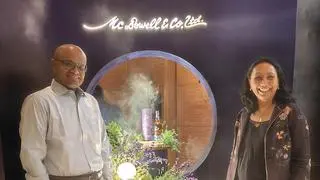Leather’s been a way of life for Da Milano’s Sahil Malik. Three generations of his family have been in the leather business though they’ve each followed different paths.
“My grandfather used to trade leather and my father used to export leather goods. I forged ahead in retail,” says Malik, who is managing director of the upmarket handbag and accessories company that bills itself as offering “affordable luxury.”
Malik’s ambitions are growing as his ₹200-crore chain spreads across the country and abroad. In India, he aims to expand from 80 stores to 100 by FY19. Overseas, he’s got three stores in Dubai and is looking to break into competitive markets like Singapore, Malaysia and Indonesia. “We’ll expand our Middle East footprint while South-East Asia is our next big expansion,” he says.

On the product front too, he’s striking out in new directions. Da Milano, which has focussed mainly on selling vibrantly-coloured, trendy leather handbags and accessories, is now making a big push into upmarket cabin and check-in luggage. “In India, ‘fashion luggage’ is still missing,” says Malik. At a different level, the company’s also reaching out to buyers aged 18-to-35 through its new retail chain Wooba, where handbags will cost around ₹4,000. At its premium Da Milano stores, handbags retail from ₹9,000 to ₹16,000. “We’ve always catered to the premium and the luxury customer and we feel there are many discerning customers with good incomes who want branded products and have been neglected,” he says. There are now two Wooba stores in Delhi with 10 more planned at a mix of malls and airports.
Cracking the code
Vital to Da Milano’s success, asserts Malik, has been that it’s “cracked the fast-fashion code”. It launches a staggering 300 new products a year so customers can always find something new. And some 30 per cent of sales are to repeat clients. An additional draw is the company’s lifetime product guarantee. Retail is “all about customer service” and “we believe once the customer purchases from us, it’s not one-time, it’s lifetime,” he says.

Right from the start, the company has relied on strong Italian styling — hence its name — and it’s got a design team in Florence. While other handbag companies play safe, using brown and black colours, Da Milano’s bags feature bold blue, green, red and neon colours and fancy clasps.
Brand consultant Sanjay Sarma, Founder, Design Worldwide, a strategic design company, says the brand has understood the pulse of the urban consumer and changing trends. “Da Milano’s range is now in sync with European trends. The brand is attracting younger customers, and visibility across retail points has improved significantly," he says.
It’s Malik’s father Surender who pays special attention to design. “I concentrate on expansions and visiting new stores and daily operations,” says Malik. His brother’s in the business too and is Dubai-based. The Maliks live on the outskirts of Delhi in a sprawling complex that houses both the Da Milano office and their residence.
Getting to this level hasn’t been easy. Malik’s father opened the first store in Delhi’s Connaught Place in 1990 but business was slow. The real retail boom for Da Milano only started in 2005 when Indian disposable incomes began rising. Crucially, Malik’s always been clear about Da Milano’s marketplace positioning. “I always passionately admired luxury brands on global platforms like Louis Vuitton, Gucci and Prada,” recalls the NIFT Delhi graduate who also studied marketing management at the LSE. “I thought there’s a customer base looking for a fine-quality product at a very affordable price. So that’s where we started — as a bridge to luxury segment.”
As Sanjay Sarma points out, this is a good niche for home-grown brands to be in as there is a gap in the market. He says, “the biggest advantage that brands like Da Milano and Hidesign offer is 100 per cent leather products and high quality craftsmanship at a price point that international brands cannot offer.” He adds that luxury (international) brands such as Coach, Hermes and Louis Vuitton retail pure leather products at exorbitant prices, whereas international bridge to luxury brands like Charles & Keith, ALDO, Kenneth Cole and Ted Baker have begun stocking more non-leather products.
The fact that players like VIP Industries are now trying to edge into this space speaks volumes about the opportunity. VIP’s Caprese, which started out as a mid-luxury brand, now describes itself as mass premium.
Today, Da Milano is making its presence felt in both domestic malls and airports. Out of 20 Da Milano stores opening in the next few months, half will be in malls and the remainder in airports. Says Malik: “Travel retail’s growing very fast because there are a host of customers travelling on a daily basis.” Da Milano’s also looking at making a big online push to connect with customers in smaller towns and cities where opening stores wouldn’t be financially feasible. In expansion mode too is the group’s five-year-old footwear brand Rosso Brunello, catering mainly to men. It sells from 10 stores and Malik’s looking at opening another 15 in the next 18 months.
“Shoes are one of our very important categories,” he says, adding the brand’s emphasis is on “young fashion” with prices from ₹5,000 to ₹8,000. Malik is optimistic about the future, declaring, “Consumerism is growing very fast.” He says: “There was a time when a lady used to buy one bag in a year. Today, we see the same lady buying six to seven bags in a year.” And this is only the beginning, he asserts.








Comments
Comments have to be in English, and in full sentences. They cannot be abusive or personal. Please abide by our community guidelines for posting your comments.
We have migrated to a new commenting platform. If you are already a registered user of TheHindu Businessline and logged in, you may continue to engage with our articles. If you do not have an account please register and login to post comments. Users can access their older comments by logging into their accounts on Vuukle.